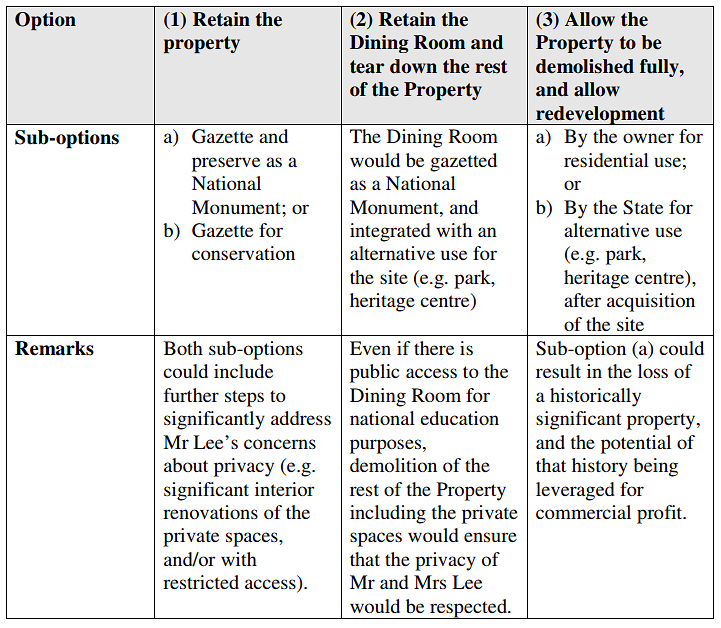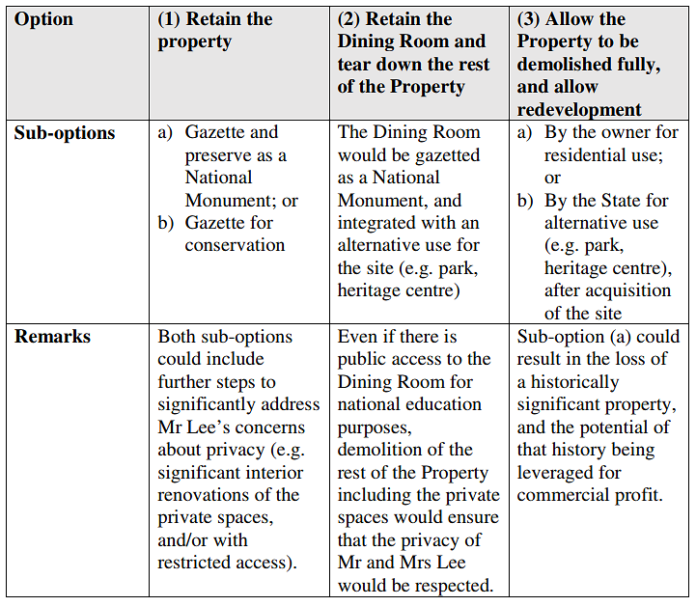SINGAPORE: The ministerial committee on 38 Oxley Road listed a range of options from preservation to demolition and redevelopment for Mr Lee Kuan Yew’s family home, in its report released on Monday (Apr 2).
While the committee acknowledged that there was “no immediate need to decide the fate of the property”, it added that the options were studied so that a future Government of the day “is better prepared to make a decision, when needed”.
The committee categorised the options into what it called three “broad” groups – retaining the property, retaining the dining room and tearing down the rest of the property and allowing the property to be demolished for redevelopment.

(Source: Ministerial Committee report on 38 Oxley Road)
OPTION 1: RETAIN THE PROPERTY
Under the retention option, the committee mentioned conservation and preservation as two possibilities, while stating that the former “does not confer the same national significance” as the latter.
Preservation under the Preservations of Monuments Act takes into consideration “historical, cultural, traditional, archaeological, architectural, artistic or symbolic significance and national importance”, it added.
“If the national and historical significance of the property is assessed to be high, one option is to preserve the property as a national monument,” the committee suggested in its report.
It added that once a preservation order is served upon the owner and occupier of the monument, the architecture of the property “cannot be modified in any manner” contrary to National Heritage Board guidelines.
The state is also legally required to acquire the house within a year from the date of the preservation order, since it is currently being occupied, the report said.
The committee suggested alternative uses for the site under this option, which could be “Civic and Community or Educational Institutional” in nature, as it reasoned that residential use “will not be tenable” after it is gazetted as a national monument. It also said the alternative use could involve restricted access to take into account Mr Lee Kuan Yew’s wish to protect the family’s privacy.
The second possibility of conservation under the Planning Act takes into consideration “special architectural, historic, traditional or aesthetic interest”, the committee explained.
“Conservation is an alternative way to retain the property for its historical and heritage value, while allowing greater flexibility for modifications to the property. If the property is gazetted for conservation, the building itself (including the dining room) will be protected by law, but more extensive modification and refurbishment of the interior will be allowed.”
The conservation option would “significantly address” Mr Lee’s concerns about privacy, the committee added.
The committee also suggested that conservation could be “an interim step” and that the Government can subsequently “upgrade” the status of the property and gazette it for preservation as a national monument at a later time.
OPTION 2: RETAIN DINING ROOM, TEAR DOWN THE REST OF THE PROPERTY
38 Oxley Road. (Photo: Howard Law)
The second category of options was to retain the basement dining room, and demolish the rest of the property.
In detailing this option, the committee highlighted that the basement dining room was assessed to be the “most historically significant” part of the property.
It added that under this option, the state could retain the room “by gazetting it as a national monument, whilst allowing the rest of the property to be demolished”.
This option would also require the state to acquire the property within a year of the preservation order.
“This is one way to fulfill Mr Lee’s wishes to tear down the building, and still retain the most historically significant part of the house, although there may be a loss of context in preserving a room alone without the rest of the property,” the committee added.
According to the report, the Preservation of Monuments Act allows for the preservation of not just entire buildings, but also parts of buildings and structures, unlike conservation which applies only to buildings.
The report went on to suggest possible plans for the dining room to be housed within a simple structure which could then be made available for “guided viewing”. It added that the structure could then be integrated as part of the overall plans for the site.
One possibility that the committee suggested was for the site to be curated as a park in view of the late Mr Lee’s support for the greening of Singapore.
Another possibility was to incorporate the structure into a new building which could be used as a research or heritage centre that allows public access for national education purposes while guarding the privacy of Mr and Mrs Lee’s way of life, the committee said.
The report included two existing glass structures – The Garden Room located in London and The Glass House located in Connecticut – as examples for this option to integrate the property with the surroundings.
OPTION 3: ALLOW PROPERTY TO BE DEMOLISHED FOR REDEVELOPMENT
The third category of options listed by the ministerial committee was to allow for the entire property to be demolished for redevelopment of the site, which can undertaken by the owner for residential use or the State for alternative uses.
This category included two possibilities: Redevelopment of the site by the owner for five-storey residential developments or to allow the state to acquire and redevelop the land for alternative uses.
The committee highlighted that if the property was allowed to be fully demolished by the owner for residential use, it “could result in the loss of a historically significant property, and the potential of that history being leveraged for commercial profit”.
File photo of 38 Oxley Road. (Photo: Toh Ting Wei/AFP)
If the state was to acquire it for alternative use, the committee suggested a public park, heritage centre, research entity or similar public institutions as some of the possibilities for such redevelopment, adding that this was one way to allow public access to the site.
“As is the current practice, the state will need to state the reasons for the acquisition (e.g. comprehensive redevelopment or public purpose) in the notice to the owner, as well as in the gazette, since it will not be for the purpose of preserving the property,” the committee said.
The report also suggested further possibilities beyond the options under the three categories. They included “amalgamating the acquired site” with part of adjacent state land to provide a “larger footprint”.
The committee reasoned that this option provides greater flexibility to meet planning needs of the proposed use of the site while retaining compatibility with the surrounding environment.





